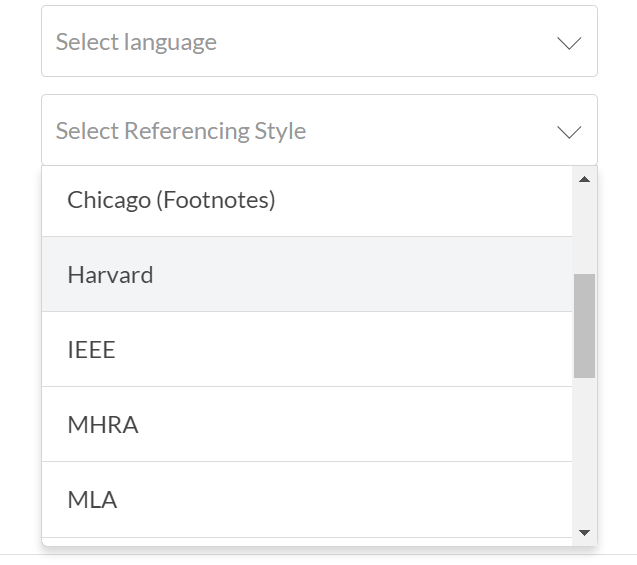Introducing APA Referencing
APA referencing is the citation system created by the American Psychological Association. It was developed for the APA’s own publications, but it is now used by universities, publishers, and scientific journals around the world.
The current rules for APA referencing are set out in the Publication Manual of the American Psychological Association, Seventh Edition. But if you don’t have this, our editors know APA referencing inside out, so you can trust us to check your work.
APA Proofreading Services
If you’re using APA referencing in a document, why not have it checked by the experts? Our academic proofreaders have in-depth knowledge of the APA system, so we can make sure your citations and references are always error free.
How To Select
APA Referencing
To let us know which referencing style to use, all you need to do is select APA from the drop-down menu while uploading your document.
We use the seventh edition of APA referencing by default, but if you are using an older version of APA, or if you have any other instructions for how we edit your work, leave a comment here to let us know.

Instant Quote
In-Text Citations In APA Referencing
APA referencing uses author–date citations. As such, citing a source means:
- Citing the source in the main text, usually at the end of the relevant clause
- Giving the author’s surname and a year of publication in brackets
- Placing a comma between the name and year
For example, we would format a basic APA citation as follows:
Effective communication can increase revenues by up to 15% (Ordan, 2002).
This changes slightly when the author is named in the text. In such cases, you simply cite the year of publication in brackets after the author’s name:
Ordan (2002) says that effective communication can increase revenues by up to 15%.
For instance, the ‘2’ at the end of the first sentence above is a citation for page 34 of the second source in the reference list. The citation at the end of the passage, meanwhile, is for the first, third, fourth, and fifth sources in the reference list.
APA Reference Lists
APA referencing requires you to list every source you cite at the end of your document, complete with publication information. This is known as a ‘reference list’. The basic rules for an APA reference list are as follows:
- Begin your reference list on a new page headed ‘References’
- List all and only sources cited in your document
- Give authors’ surnames first, followed by an initial or initials
- List sources alphabetically by surname of the first listed author (e.g. ‘Aaronson & Zedwick’ would come before ‘Zedwick & Aaronson’ in an APA reference list)
- List multiple sources by the same author chronologically by year of publication
- Use sentence case for book and article titles (i.e. only capitalise the first letter of the first word of titles and subtitles, plus proper nouns)
- For journal titles, use the same capitalisation as the original publication
- Italicise the titles of longer works, such as books and journals
- Use a half-inch (1.27 cm) hanging indent for each line after the first
However, make sure to check your style guide on this. Some universities have in-house rules for formatting reference lists, even if they use APA citations.
The format of reference list entries in APA depends on the source type (e.g. book, journal article, website). In all cases, though, you will need to give enough information to identify the source, including the name of the author and title. For instance, a book with a single author would be listed like this:
Smith, G. 2001. Innovations in fruit preservation. Penguin Books.
For other reference formats and more information, see our blog and the APA Style website.
Quoting Sources In APA Referencing
If you quote a source in APA referencing, make sure to include a page number at the end of the citation after a comma. This will point the reader to the quoted text:
It is ‘crucial to adapt to changing technology’ in business (Lazinski, 2018, p. 34).
The citation above, for example, tells us that the quote comes from page 34.
As with basic citations, this format changes slightly when the author is named in the text. In APA, this means citing the year of publication after the author’s name, but giving the page numbers after the quotation itself. For instance:
Lazinski (2018) says that it is ‘crucial to adapt to changing technology in business (p. 34).
Referencing Styles And Systems
Our expert editors can work with a range of referencing styles, including:
We can work with other referencing styles on request, too. Just let us know which system you’re using when you upload your work, and we’ll tailor our service accordingly. For more information on legal referencing styles, such as OSCOLA and AGLC, see our dedicated legal referencing page.




